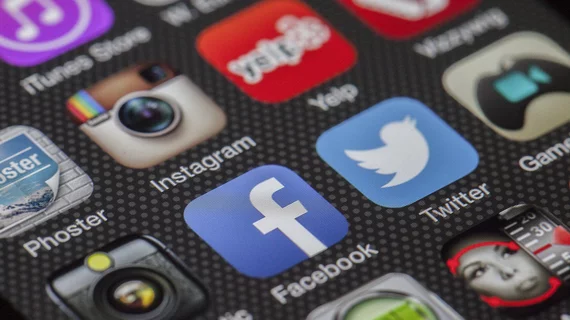Twitter is tops for diagnostic radiology residency programs using social media for education, networking and/or trainee recruitment.
With 121 of 196 programs tweeting, some 62%, the platform with the bluebird mascot named Larry is well ahead of Instagram (47%) and Facebook (38%).
The standings were tallied by radiology researchers en route to concluding that social media offers a worthwhile channel for “efficiently and effectively” communicating with a wide array of radiology residency stakeholders.
Current Problems in Diagnostic Radiology published their analysis online July 23 [1]. Its authors are Arun Murugesan, MD, and Sahil Patel, MD, of Northeast Ohio Medical University, Puneet Bhargava, MD, of the University of Washington in Seattle and Erin Cooke, MD, of Vanderbilt University in Nashville.
The team identified programs listed in the American Medical Association’s FREIDA residency database, searching for each on the three social media platforms mentioned above. They also searched out programs not in FREIDA and included programs that lacked “official” accounts but frequently used social media to post residency-related content. They used Microsoft Excel to analyze descriptive and statistical features in the data.
Also of interest in the key findings, the researchers found the average radiology residency program went live on Twitter in 2017 (± 2.6 years) and had 1081 ± 1438 followers.
By comparison, Instagram accounts had a mean of 1078 ± 1175 followers.
Up and Coming SoMe Platforms With Which Radiology Will Likely Need to Reckon
Examining other social media platforms, the team found TikTok the fastest-growing. They cite a 2021 study showing that radiologists represent a modest slice of TikTok account holders but post the majority of the application’s clinical content.
Because TikTok is sparsely populated by radiology residencies, it’s a platform that “offers substantial development opportunities as Generation Z matriculates to medical school,” the authors write. “Radiology residency programs could find a competitive advantage in investing resources in developing TikTok accounts to bring more awareness to not only their residency program but also to the specialty of radiology.”
Also drawing a mention from Murugesan and co-authors:
- YouTube. Noting radiology’s growing educational footprint on the popular video platform, the authors highlight the radiology residency program at Dartmouth-Hitchcock. YouTubers there created custom videos highlighting their program and subsequently conducted a study that found that 84% of respondents were positively influenced to apply to their program due to these videos, they write. “Radiology residency programs should utilize YouTube in these ways to enhance education, promote their program and to provide an extra level of information not easily obtained from their residency program website.”
- Discord. Radiology residents are increasingly logging on to a channel here called RadDiscord, Many do so to prepare for board exams, sharing notes with like-minded individuals among almost 3,000 medical trainees.
Might Today’s Also-Rans Become Tomorrow’s Pacesetters?
The medical professional platform Doximity gets only a passing mention, and LinkedIn, which has well more than 800 million career-minded members gets none at all. So too Reddit (400 million-plus active users as of 2020).
Also passed over—but perhaps worth a look in a future overview of social media options for directors of radiology residency programs—are WhatsApp, WeChat, Messenger, Telegram, Snapchat and Douyin. All of these have at least 613 million users in 2022.
And indeed, looking ahead, Murugesan et al. comment that further development across all social media platforms “presents a unique opportunity to connect with students prior to medical school and shape the narrative around the specialty.”
More:
There has been a lot of misinformation disseminated to medical students about radiology. One study showed one in six students did not pursue the specialty due to fear of artificial intelligence (AI) replacing radiologists. Those in the specialty know that fears of AI replacing radiologists have been exaggerated and can be refuted by pointing to numerous sources for evidence. Social media offers the means to dispel misinformation while simultaneously educating students on a broad range of radiology-related topics.”

